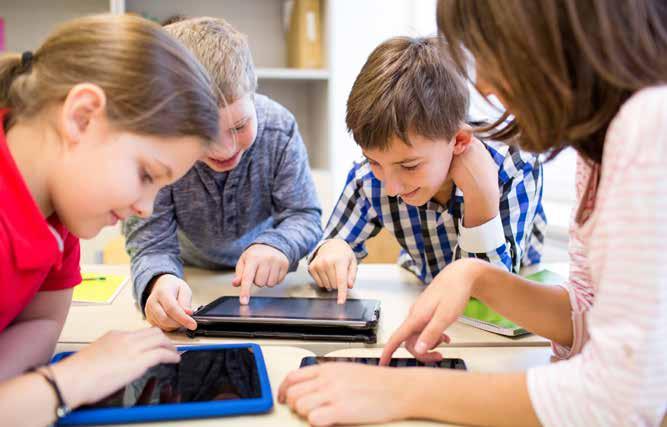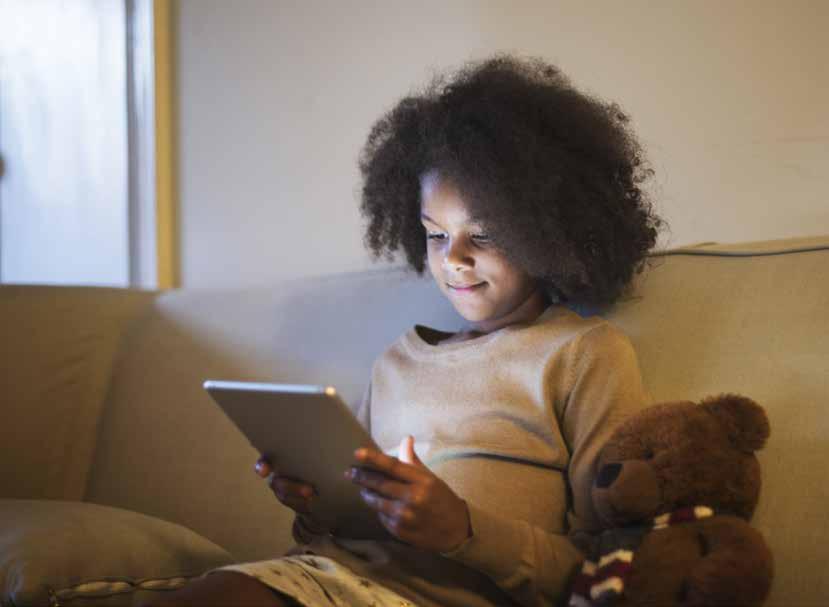Tips for parents on kids & tech
Technology can be empowering for kids but can impact their development too. How can you balance this and make technology work for your family?
In the digital age we live in, parenthood involves more than just helping a child navigate the real world. It now means guiding them through the virtual one too. It’s clear that technology is here to stay, so it’s essential to teach kids to use it in a healthy way, by developing skills and habits that shape them into successful digital citizens. Let’s delve into what that means.

HOW TO HANDLE ONLINE MEDIA AT HOME
Create a family media use plan
Media should work for you, your household values and your parenting style. When used moderately and appropriately, it can be a great tool and enhance everyday life. Unfortunately, it can sometimes displace more important activities like face-to-face interaction, family time, outdoor play, exercise, unplugged downtime and sleep. So, it’s essential to use it well and a family plan can provide ground rules and structure to make this happen.
Treat all environments the same way
The same parenting guidelines apply in both real and digital environments. Set limits; kids need them, expect them and respond well to them. Know your children’s friends, both online and off. Know what platforms, software, and apps your children are using. Keep an eye on what sites they visit and what activities they take part in online, exactly as you would in the real world.
Have limits and prioritise playtime
Like any other activity, it’s a good idea to have reasonable limits around media use. Playing offline, in an unstructured way, is important for children – it stimulates creativity and mental relaxation. It’s healthy to make unplugged playtime a priority every day and it promotes better concentration, self-assuredness and mental resilience.

Share screen time
Watching, playing and engaging together during screen time encourages happy social interactions, bonding and learning. Playing a video game with your kids can be a great way to show good sportsmanship and strategy. Watching a show with your children can be a lovely opportunity to talk about your own life experiences and offer guidance. Don’t just watch over kids when online – interact with them! This way you can understand what they are doing and be a part of it.
Set the right example
When you model discipline and good manners around media, children will pick that up and copy it. This extends to limiting your own media use. Less media time for everyone you will all have more time together. Strong relationships are built from making time to interact with your kids without the distraction of screens and phones.
Face-to-face communication
Very young children learn best through two-way communication. Speaking back and forth is critical for language development, even when your baby is simply babbling and making sounds. Conversations can be face-to-face or by video chat if a parent or grandparent is abroad. Research tells us that it’s the two-way exchange that boosts language skills, much more so than just listening or the one-way interaction of a screen.
Media use for younger kids
When toddlers are younger than eighteen months, avoid digital media use aside from video chatting. For children between this age and two, watch digital media with them because this way they can learn from watching and talking with you. Keep screen use very limited for children between two and five – up to an hour of high-quality programming per day. Watching these programmes together with parents is healthier for young children. They learn best when what they have just learned through a screen is then re-taught in the real world. So, if the programme looks at the numbers 1-3, repeat this lesson later when you are having dinner or spending time with your child.
Tech-free spaces
Family mealtimes, other family and social gatherings and children’s bedrooms are best kept screen free. Turn off televisions that aren’t being watched as even background TV can interfere with face-to-face time with kids. Charge devices overnight, outside your child’s bedroom. This helps them avoid the temptation to use their devices when they need to be asleep. These practices encourage more family time, healthier eating habits and more restful sleep.
Technology as a distraction
Media can be very good at keeping kids calm, quiet and distracted as part of a number of ways your children learn to settle themselves. However, it’s better if it’s not the only way. Children need your guidance on how to name and handle their emotions. It’s good to teach them to calm down through breathing and talking when upset. Technology is not a substitute for these things and it’s important to find strategies other than media for emotions.
Research apps
There are over 80,000 apps that are marketed as educational, but there is very little research demonstrating their actual quality. Apps labelled “interactive” should involve more than just pushing and swiping. Look up reviews around age-appropriate apps, games and programs or talk to your peers to gather your own information, so you can make the best choices for your children.
Teenagers and online time
Digital relationships are part of the modern teenage experience. Social media can support their social connection and allow them to explore more about themselves, but it can also be a negative space. It’s good to make sure your teen is behaving appropriately in both the real and digital world. Lots of teens need to be reminded that a platform’s privacy settings do not make things actually private, and that images, thoughts and comments shared online will forever be a part of their digital footprint. Keep lines of communication open and encourage them to ask questions or share their worries.
Digital safety
It’s healthy to talk to your child about the importance of privacy and the dangers of online predators. Teens should be taught that once content is shared with others, they cannot delete it completely. This includes sending or sharing inappropriate pictures. Your child may be unaware of privacy settings. Explain clearly that predators use social media, chat rooms and online gaming to contact children. It’s important to have these conversations and to make sure your child follows your agreed digital safety rules.
Mistakes will happen
Kids are bound to make mistakes while online. React with empathy and turn a mistake into a teachable moment. Certain things such as bullying or posting harmful images may signal a deeper issue. Nobody cares more about your child’s digital wellbeing than you, so be sure to monitor your child’s behaviours carefully. Don’t be afraid to seek out professional help if that’s something you think your child needs.
FINALLY…
Teaching children to use technology healthily can help them learn in fun and engaging ways, express their creativity and stay connected to others. Parents who are aware of online safety and the negative effects of too much screen time are better able to prioritise face-to-face connection and set their kids up for the best outcomes.











Comments